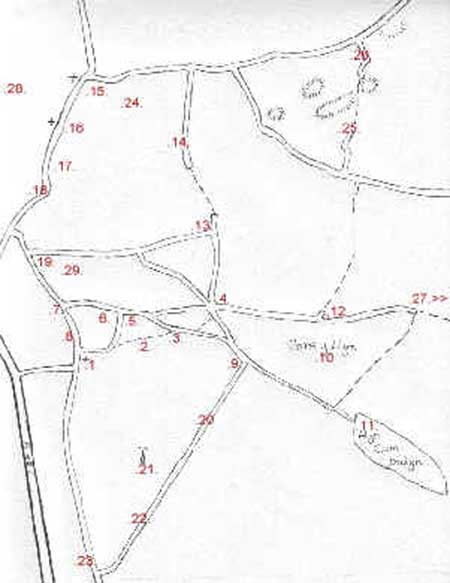Circular
Walks around Nebo and Nasareth ~ Suggested
Routes and Map
Places
of Interest
Please
click on the individual numbers on the map for further
information about each location, or alternatively
see the corresponding descriptions below.

1. Capel
Nasareth - Congregational (founded 1823, rebuilt
1867). Nasareth shop and Post Office.
2. Glanyrafon.
3. Ffordd
Pant y Gôg
4. Nebo
- School (opened 1873), Community Room, Old Post
Office, Playing Field, site of Nebo
Chapel (1861 -1981).
5. Mediaeval
well - Listed by Gwynedd
Archaeological Trust.
6. Hafod
yr Esgob - Dr
David Jones' house 1779 -1839 (Hen Ddoctor Mynydd)
who published a famous herbal 'Llysielyfr Teuluaidd
Jones Llanllyfni'.
7. Fine
views to Dinas Dinlle, Anglesey, Llanddwyn Island
and Holyhead.
8. Eisteddfa
Isaf - Grade 2 listed cottage. Eisteddfa Rhedyw is
nearby among Cerrig Mawr where, according to tradition,
the Patron Saint of Llanllyfni Parish lived in the
fourth century. Remains of the old sawmill may also
be seen.
9. Pant
y Gôg - ruin at the bottom of the steep slope
leading to the mast.
10. Cors
y Llyn - the last part of the common land,
where residents would cut peat and graze their
animals. A Site of Special Scientific Interest.
11. Llyn
Cwm Dulyn - formed after the last Ice Age, it has
been the reservoir for Dyffryn Nantlle since the
1880s. It is one of the lakes of Snowdonia where
the arctic char is found, which has survived here
since the Ice Age. On the northern slopes - Braich
y Llyn - are two mediaeval 'summer dwellings', huts
where shepherds stayed with their flocks from 1st
May to 1st November.
12. Rhos-las -
'A patchwork of fields and scattered homesteads'.
Many ruins as well as houses totally refurbished
may be seen, where there was once a community of
smallholders and quarrymen. The area became depopulated
in the first half of the 20th century when the quarries
closed. (Further reading on the Families of Rhoslas and the Smallholdings of Rhoslas is available.)
13. Pont
Lloc - A standing stone may be seen in a field nearby.
14. Public
Turbary Road - The
main route used by Llanllyfni residents to take peat
and wood from the Common. The early congregation
of Methodists would meet in Buarthau farmhouse, between
1763 and 1812, but in an earlier period, local people
would meet by custom in one of the fields each Sunday,
and 'Gwen y Canu', the old witch, would come there
to put her curse on those who attended this service!
15. Llanllyfni
- Saint
Rhedyw's Church (which dates back to the fourth
c., The old village well, The Quarryman public house.
16. Llanllyfni
School (1862) The
Scotch Baptists Cemetery ('Bara Caws'). Salem
Chapel (Presbyterian).
17. Gorffwysfa
Cemetery, (Hendre Forion).
18. Old
Turnpike - cross the new
footbridge, site of the Roman Bridge destroyed in
the great floods of 1935.
19. Capel
Bach - the Methodists' first
'Schoolhouse' on Llanllyfni Mountain - built in 1826.
It was established as a church in 1843.
20. Fine
view north to Dyffryn Nantlle.
21. Nebo
Mast - the Arfon radio and television mast
- height 601 metres.
22. View
to the south (Cardigan Bay) and west (Caernarfon
Bay). Rare plants, animals and birds.
23. An
area exceptionally rich in prehistoric remains -
hut circles, Stone-age burial mounds, Iron Age farmsteads,
etc.
24. Rhos
yr Unman - according to
legend, a host of Irishmen (Vikings from Dublin,
more than likely) were seen encamped by Upper Nantlle
Lake by a shepherd tending his flock on Braich y
Llyn in Cwm Dulyn one summer long ago. He hurried
for assistance from the army. It is said that the
soldiers had dug some defensive trenches here. When
the raiders approached, they were overwhelmed by
the Welsh.
25. The
Quarrymen's Road -
past Glangors, birthplace of R. Sulyn Roberts writer
and pioneer of the Workers Educational Association
and home of the agricultural botanist and naturalist
Dr R. Alun Roberts. In the distance may be seen the
ruins of Bryn Llidiart, birth-place and dwelling
of the poet Mathonwy Hughes, National Eisteddfod
winner.
26. Tanyrallt,
and some of Dyffryn Nantlle's Quarries.
27. The
Path to Bwlch Cwm Dulyn / "The Miners Path" - led to the old manganese mine in the direction of Cwm Silyn, and to
the old copper and lead mines in Cwm Pennant over
Bwlch
Cwm Dulyn. From this path "One hundred yards from the mountain-top", R. Williams Parry and two friends saw 'The Fox', immortalised in the sonnet.
28. Cae
Du. The house of Henry Robert Parry,
one of the most brilliant harpists of the period
'who was taught his craft by the Ancient Harpers
of Wales'. His most famous pupil was Blind
John Parry, born at Bryn Cynan in c1710, (Although
there is a Bryn Cynan in Pontllyfni, his first patrons
were the Griffiths family of the Cefn Amlwch Estate,
Bryn Cynan, Nefyn. They bought him his first triple.)
He became harpist to Sir Watkin Williams Wynn and later,
to the Prince of Wales; his musical ability was greatly
admired by the composer Handel and it was he also who
inspired the English poet Thomas Grey when he wrote
'The Bard'. He died in Ruabon in 1782.
29. Pen
Pelyn. In a house nearby dwelt 'Martha
of Llanllyfni Mountain'. She claimed to be in
contact with the 'Invisible Ones', but it was all
deception.
Suggested
Routes
4-12-4.
A relatively easy walk, mostly flat.
1-2-3-4-5-6-7-8-1.
Nebo and Nasareth circuit.
1-2-3-4-13-24-18-19-8-1.
Walk around Foel y Rhiw.
1-6-5-4-13-14-15-16-17-18-19-7-8-1.
Nebo, Nasareth and Llanllyfni circuit.
1-2-3-4-12-25-26-14-13-19-7-8-1.
The Quarrymen's Route.
1-23-22-21-20-9-11-10-12-4-3-2-1.
Walk around the mast.
|